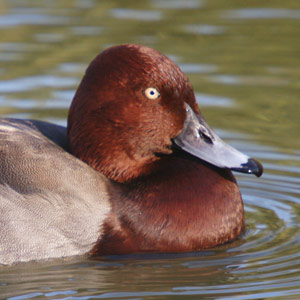Magazine | Études
La philopatrie hivernale chez les Anatidés

Ce mâle de Fuligule hybride nyroca (Aythya nyroca) x milouin (A. ferina) est noté chaque hiver dans le parc de Pont de Gau (Bouches-du-Rhône) depuis 13 ans !Photographie : Benjamin Vollot
Introduction
La philopatrie est la tendance de certains individus à rester ou à revenir à un endroit donné, en général là où ils sont nés. Un oiseau peut être fidèle à un site de nidification, de halte ou d’hivernage. Le degré de philopatrie influence la structure génétique des populations si elle concerne un site où se forme le couple et/ou a lieu la reproduction. La formation des couples se produit généralement durant la saison de reproduction, et donc la plupart des études ont porté sur la fidélité aux sites de reproduction. Mais chez les Anatidés (canards et oies), cet appariement a souvent lieu en hiver. Les oies, les cygnes et les canards marins (eiders, hareldes, garrots…) sont très fidèles à leur site d’hivernage, tandis que le taux de retour des canards de surface et des fuligules semble plus faible.
Le parc ornithologique de Pont de Gau en Camargue nous a décrit le cas d’un Fuligule hybride nyroca x milouin qui était observé chaque année depuis 13 ans entre la fin du mois d’octobre et le mois de février !
Dans cet article basé sur une synthèse très détaillée de Gregory J. Robertson et Fred Cooke, nous vous proposons une présentation de la philopatrie hivernale des Anatidés et de ses avantages écologiques et génétiques.
Abstract
Broadly, philopatry is the behaviour of remaining in, or returning to, an individual’s birthplace. Species that return in consecutive years to the same breeding site or territory exhibit breeding philopatry or site fidelity. Migrating animals also exhibit philopatry to certain important areas on their route : staging areas, stop-overs, molting areas and wintering grounds.
The level of philopatry can have a significant influence on the genetic structure of populations, but only at the stage of the annual cycle when pair formation and gene exchange occur. Because pair formation in birds typically occurs during the breeding season, most studies have focused on breeding-site philopatry. Waterfowl (ducks, swans and geese) are an important exception to this pattern because pair formation often occurs during the winter months. Geese, swans and sea ducks (eiders, long-tailed ducks, goldeneyes… ) show how levels of winter philopatry, while return rates of dabbling ducks and Pochards seems lower. However, the ornithological park of Pont de Gau (Camargue, France) has presented us the case of an hybrid Ferruginous Duck x Pochard that is watched there every winter for 13 years between the end of October and the month of February !
In this paper, based on a synthesis by Gregory J. Robertson and Fred Cooke, we propose you a presentation of winter philopatry in Anatidae and the genetic and ecological benefits of this behaviour.
Poursuivez la lecture de cet article, en vous abonnant dès maintenant !
Découvrez les Archives d’Ornithomedia.com
Pour seulement 10,00 €TTC/an (ou 6,00 € les 6 mois)
Profitez de plusieurs centaines d’articles en accès illimité et sans aucun engagement.
Compléments
À lire aussi sur Ornithomedia.com
- Les fidèles oies de Cattenom (Moselle)
- Identifier et chercher la Bernache cravant du Pacifique en hiver en France
- À la recherche des Bernaches à cou roux dans la Dobroudja bulgare du 7 au 15 janvier 2006
- Canards pilets au ventre ocre : ouvrez l’oeil
- Séances collectives d’excitation sexuelle chez l’Eider à lunettes
À lire sur le web
Le site web du parc ornithologique de Pont de Gau : www.parcornithologique.com
Ouvrage recommandé
Le guide Ornitho de L. Svensson
Sources
- Gregory J. Robertson et Fred Cooke (1999). Winter philopatry in migratory waterfowl. The Auk (116). pages 20-34. www.jstor.org
- Josef Hofer, Fränzi Korner-Nievergelt, Pius Korner-Nievergelt, Matthias Kestenholz. An Indication of Long-Term Group Formation in Tufted Duck Aythya fuligula. Swiss Ornithological Institute
- Blaize Christine et David Hemery (2013). Suivi migration et hivernage 2012-13 du fuligule milouin au lac des Minimes. Grumpy Nature. http://associationgrumpynature.files.wordpress.com/2013/09/rapportmilouin2012-13-sept2013.pdf
- Matthieu Guillemain et Alain Caizergues (2010). L’étude des canards par le biais des marques nasales : intérêt de la méthode et premiers résultats. Ornithos (17-5). Pages 290-297. http://files.biolovision.net/www.ornitho.ch/userfiles/0110Marquesnasales.pdf





Aucun commentaire sur ce sujet
Participer à la discussion !